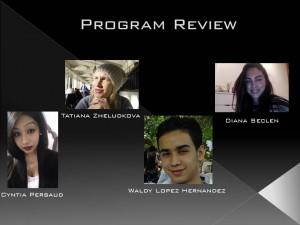-Cyntia Persaud
-Tatiana Zheludkova
-Waldy Hernandez Lopez
-Diana Seclen

ARCH 2330 – SPRING 2015 – King
A City Tech OpenLab Course Site


Our goal is to make the OpenLab accessible for all users.
Our goal is to make the OpenLab accessible for all users.
Well done presentation, very complete and has plethora of variety of information. How apart should the lights be from each other in order to provide good lighting in a room?
Lighting needs are dependent on factors such as group use, occupancy, size and shape of the room and lamp wattage.
Then we do LPD calculations, page 14 in presentation.
Great presentation with a lot of information.
Do the types of programs relate to one another or can they be placed in any order?
it depends on the type of program and use
nice presentation! I appreciate so many information and got my attentions by hearing you guys asked professors to understand more.
Is there any requirement or limitation of materials depending on specific programs?
Hey all,
The slides are great! What are some example lobbies that may need a 24/7 HVAC system? Also, is Long Gone a Spa? Do specific rooms require automated lights that turn on when a person enters a room? As far as a classroom, workshop, gym, or spa, which would you say may require the most lighting in an overall sense? Might there be a system that supports why the classifications groups that have sub-groups require specific spatial areas? Lastly which flame spread class is more resistant? Overall, well-organized, and the presentation was intriguing. Good job.
1) Lobby spaces requiring 24-hour operation should be provided with a dedicated HVAC system.
2) Long Gone is a spa. Good observation:)
3) All indoor lighting systems must include a separate automatic shut-off control, such as an occupancy sensor or time switch. There are no such requirements for automatic on controls.
4) Definitely classrooms and workshops
Aside from the LPD, what sort of requirement/recommendations for lighting in corridor/transition areas?
Wattage/Efficiency Limits
Good job on the presentation! Which method of the LPD calculation is most often used? Some examples of the calculations would help as well.
The building area method is simpler but can lack some flexibility. The space-type method requires more calculations but may provide a higher overall LPD allowance depending on the mix of spaces within the building.
I enjoyed the presentation. My question will be can the program have a connection with one another?
if the two programs have the same use type or are similar then it is possible for them to be connected
About the lighting, Is there a specific intensity in lighting when it comes to different rooms or different areas of a room?
The term intensity is used to describe the rate at which light spreads over a surface of a given area some distance from a source. The intensity varies with the distance from the source and the power of the source. The answer is yes and yes.
excellent presentation, and great information. How can the occupancy load effect a program space?
its a beneficial presentation. i would like to to explain more about the relationship between what each one of you have talked about. for example: the effect of the user group and type of light associated with it .
When we calculate LPD we should take in consideration use group and space; therefore LPD of the classroom twice higher then LPD of corridor
what’s the difference between warm lighting and cool light?
Cool and warm lighting is all about color temperature – a characteristic of visible light. Color temperatures over 5,000K are called cool colors (bluish white), while lower color temperatures (2,700–3,000 K) are called warm colors (yellowish white through red)
Warm to Warm white – living room, bedroom, hallway
White to Cool white – kitchen, study, bathroom, cupboard, office, retail